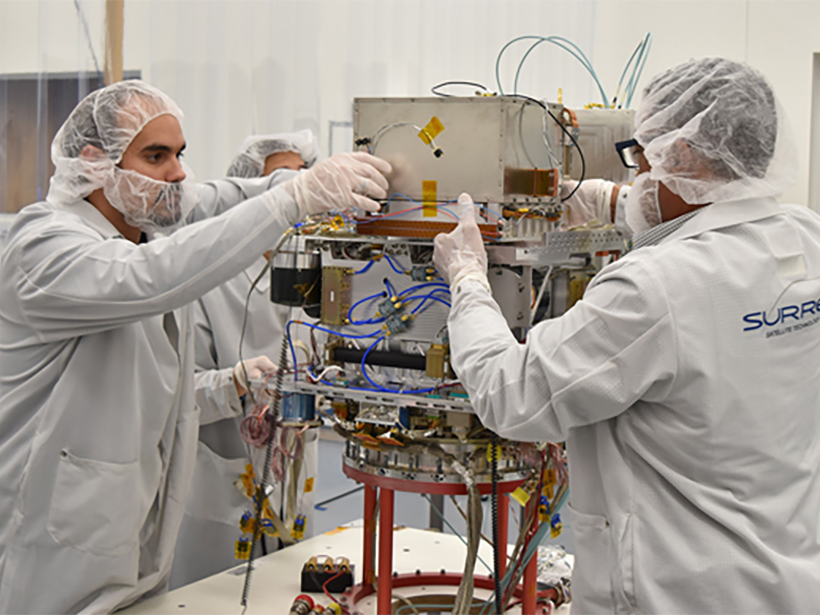Atomic clocks—the world’s most precise timepieces—are the basis of modern-day navigation and telecommunication. This month, an ultraprecise, toaster-sized atomic clock is slated to leave our planet’s surface and enter low-Earth orbit. It’ll pave the way for placing atomic clocks on spacecraft, an advance that will allow interplanetary spacecraft to more quickly and accurately determine their location in space. That’s important as humans prepare to travel to other planets like Mars.
Light Is Fast, But Space Is Big
Here on Earth, we pretty much know where we are at all times: The signals that zip between our smartphones and orbiting GPS satellites do so in far less than a second. That’s thanks to the relative proximity of GPS satellites (only about 20,000 kilometers away). But things are different for spacecraft, which don’t currently have GPS capabilities.
To determine where a spacecraft is, Earth-based researchers send it a radio signal, which it returns. Atomic clocks on Earth time the journey of those radio waves, and a bit of math reveals the spacecraft’s distance from Earth. Measuring location is therefore “fundamentally a problem of very accurately measuring time,” said Jill Seubert, the deputy principal investigator of the Deep Space Atomic Clock Technology Demonstration Mission at NASA’s Jet Propulsion Laboratory in Pasadena, Calif.
Alerting a spacecraft of its location requires a third radio signal, however, and all of that light travel time adds up. For a spacecraft near Mars, the delay can top 40 minutes, said Seubert.
An Atomic Clock of Their Own
Much more efficient navigation would be possible, researchers realized, if spacecraft were equipped with their own atomic clocks. They’d then be able to receive a radio signal from Earth (typically from one of NASA’s Deep Space Network antennae located in California, Spain, and Australia) and very accurately measure the signal transit time to calculate their distance. Rather than sending radio signals on three trips, only one would be needed. That’s the idea behind the Deep Space Atomic Clock.

The Deep Space Atomic Clock is substantially smaller and lighter than most earthbound atomic clocks, roughly the size of a four-slice toaster and just 16 kilograms.
It also runs extremely consistently. Its stability derives from a small cloud of mercury ions that “steer” the frequency of a quartz oscillator. The principle hinges on the mercury ions changing energy state when they absorb a particular frequency of microwave radiation (40,507,347,997 hertz). By continuously correcting the frequency of the quartz oscillator, scientists ensure the steady “heartbeat” of the Deep Space Atomic Clock.
“It can go about 10 million years before it would drift off by 1 second,” said Seubert. “It’ll be the most stable clock in space.”
Can’t Call a Postdoc
Deep Space Atomic Clock will launch aboard a SpaceX Falcon Heavy rocket from NASA’s Kennedy Space Center in Florida as early as 24 June. It will enter low-Earth orbit at an altitude of roughly 720 kilometers and remain there for about 1 year while scientists analyze its performance.
Turning it on for the first time—after its jarring rocket flight—will be an achievement in and of itself, said Seubert. “If one piece breaks, I can’t send a postdoc.”
Scientists aren’t sure yet which spacecraft will be the first to be outfitted with a version of the Deep Space Atomic Clock. Given the large number of spacecraft and rovers imaging and exploring Mars’s surface, however, something near the Red Planet may win out, said Seubert.
“While there are no specific plans yet, the next Mars orbiter would be a great candidate to fly this technology as it could demonstrate autonomous navigation, support radio science experiments, and perhaps one day serve as a node in a future Mars network,” she said.
A GPS-Like Network Around Another World
“Once we have this technology demonstrated…we could build GPS-like networks at other planets and moons.”
Seubert sees a lot of uses for atomic clock technology in space. For instance, she envisions building constellations of Deep Space Atomic Clocks orbiting other worlds to provide inhabitants with location information.
“Once we have this technology demonstrated…we could build GPS-like networks at other planets and moons,” Seubert said. “We use GPS every dang day here on the Earth. I think we take it for granted. If we’re sending humans to Mars, how are they going to find their way around?”
For Seubert, who has been working on the Deep Space Atomic Clock since she joined the Jet Propulsion Laboratory in 2011, the upcoming launch is a big deal. She’ll be flying to Florida to watch it.
“I will be there,” said Seubert. “I’ve been waiting a long time for this.”
—Katherine Kornei (@katherinekornei), Freelance Science Journalist
Citation:
Kornei, K. (2019), Ultraprecise clock will facilitate space exploration, Eos, 100, https://doi.org/10.1029/2019EO126661. Published on 21 June 2019.
Text © 2019. The authors. CC BY-NC-ND 3.0
Except where otherwise noted, images are subject to copyright. Any reuse without express permission from the copyright owner is prohibited.

